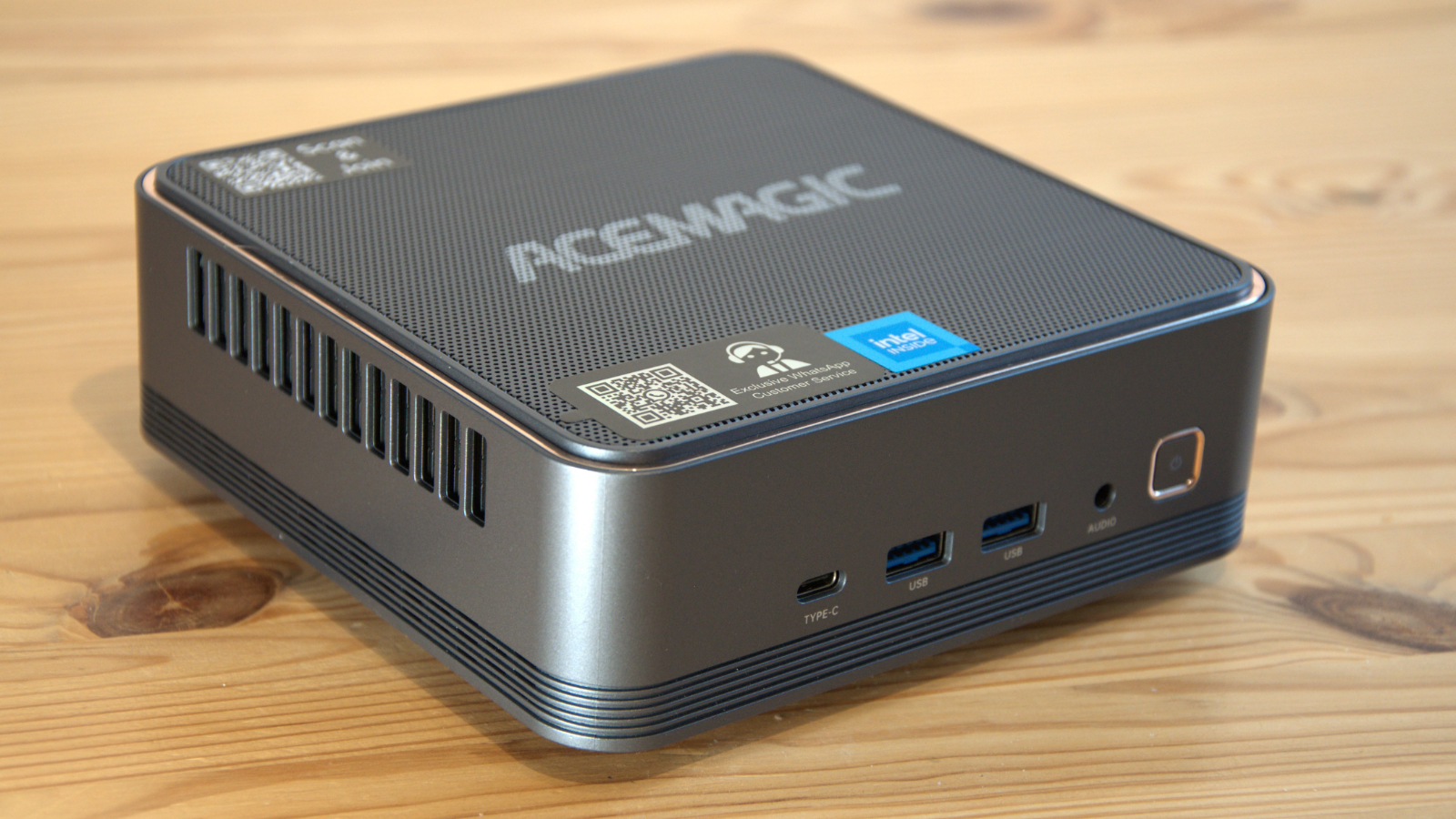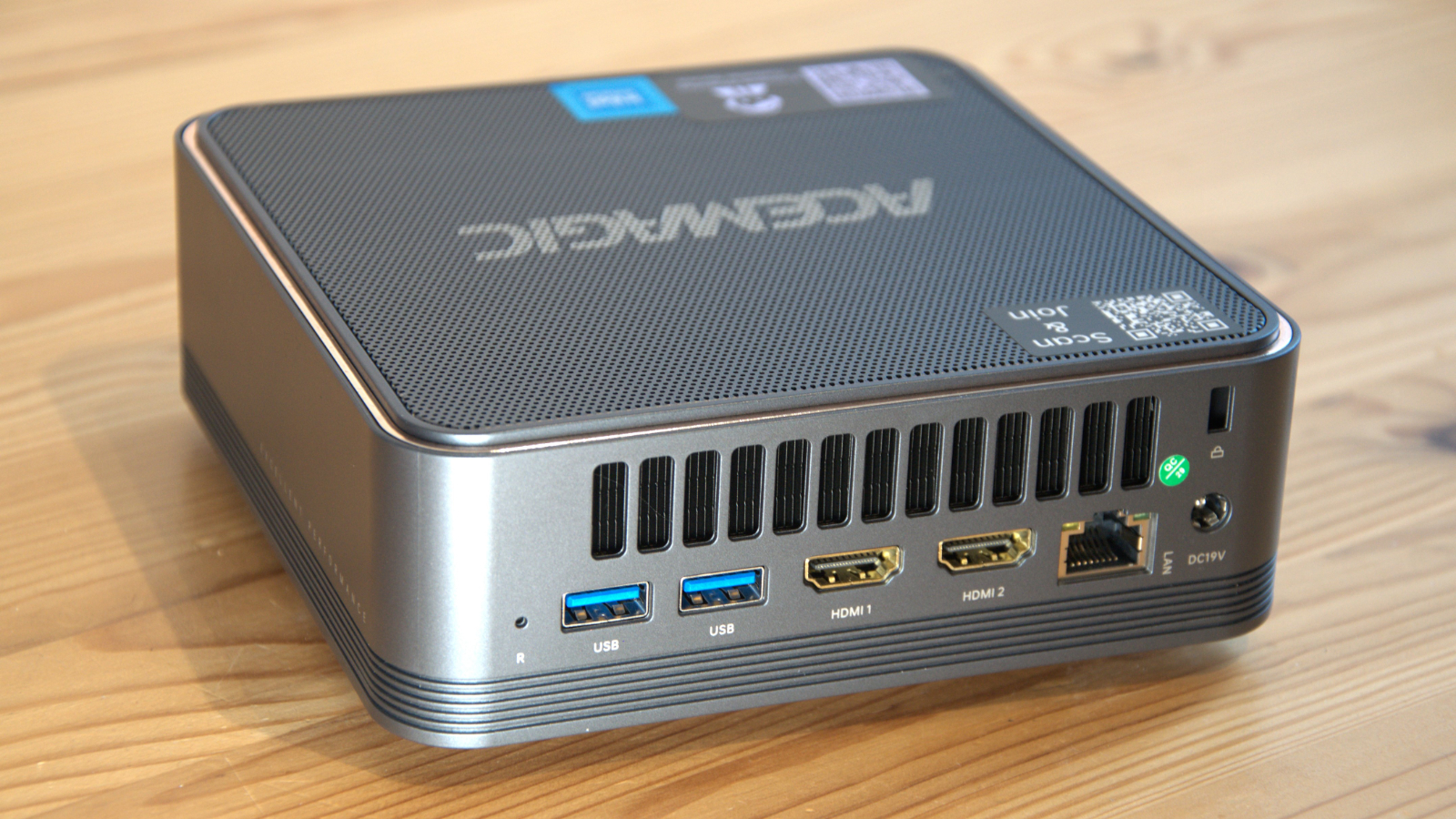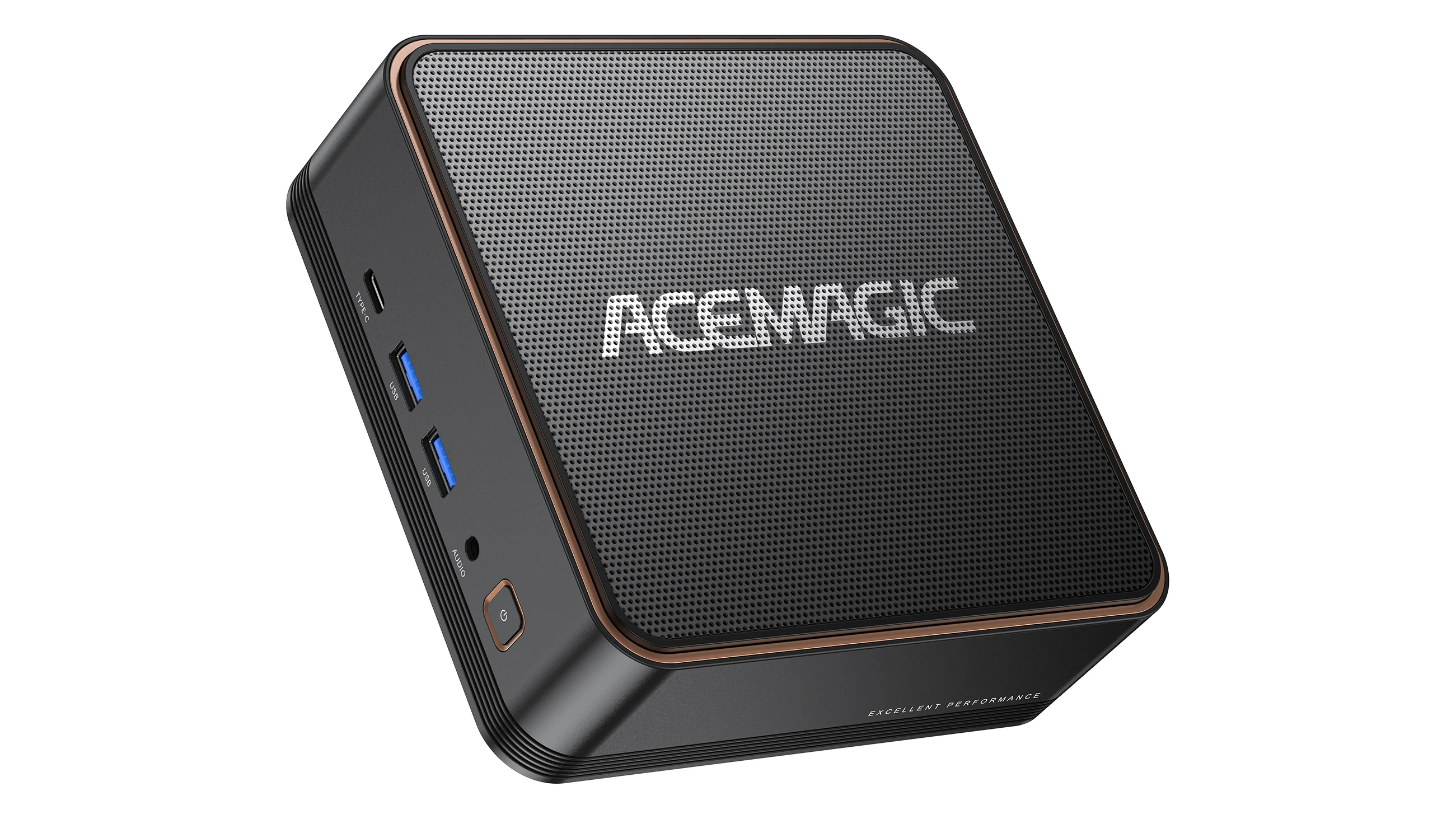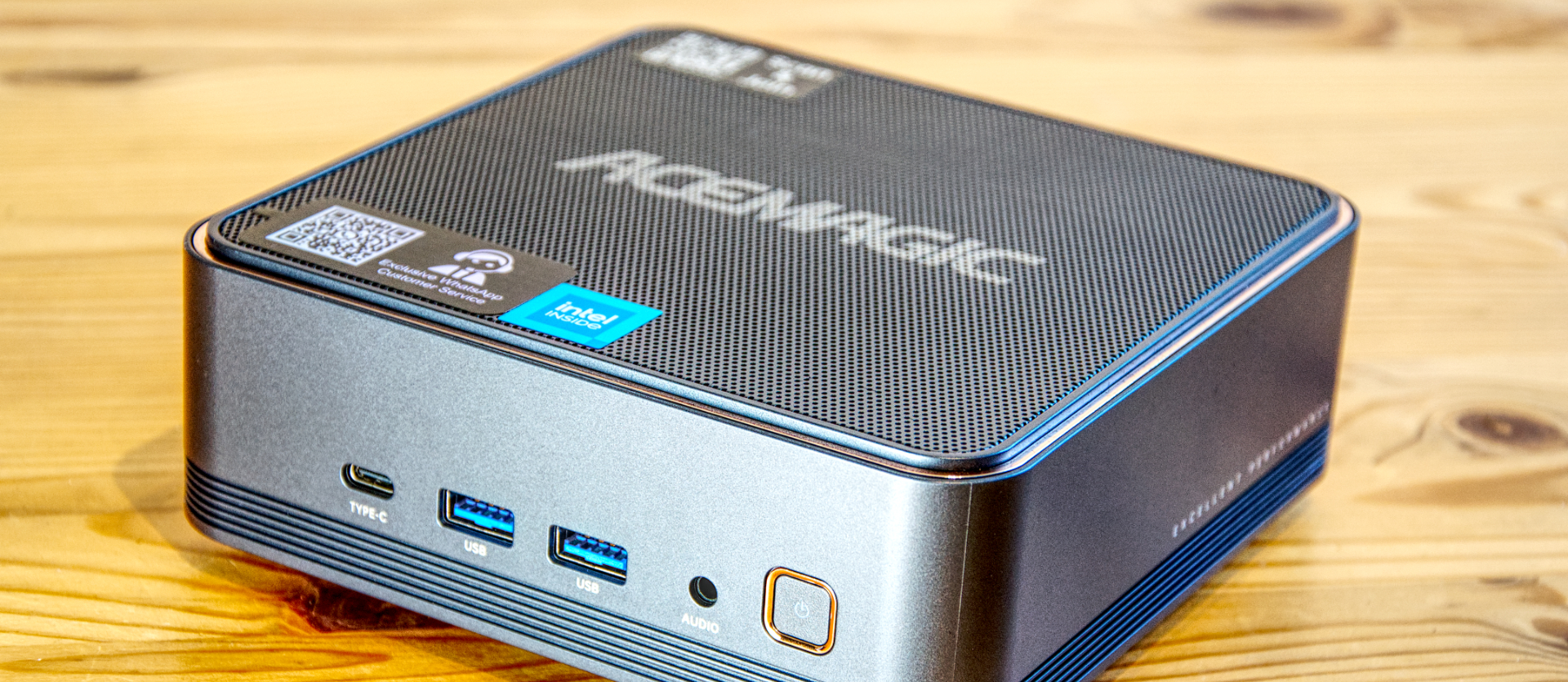Early Verdict
Finally, Intel has an answer to AMD's previous generation Ryzen 9 and Radeon 680M, but its joy may be short-lived and not cheap. Given the price point, the Acemagic build quality should be better than this, and the port selection should be wider.
Pros
- +
Powerful
- +
Best Intel integrated GPU so far
- +
Dual M.2 Slots
Cons
- -
Excessive amount of plastic
- -
Fan can be noisy
- -
No Thunderbolt ports
Why you can trust TechRadar
30-second review
Intel has been promising to release some genuinely special mobile processors for a while, and given how poor some of the Gen 10, 11, and 12 chips were, it's about time, too.
Finally, the pure Core branding has exited stage left, and we're now invited to gaze at the handsome profile of the first Core Ultra series.
The F2A Mini PC by Acemagic is powered by the Intel Core Ultra 5 125H, an entirely new design that sports fourteen cores split now into P-Cores, E-Cores and new L-Cores (for Low-power Efficiency cores), and there are 4, 8 and 2 of those types.
In addition to the new core layout, this is the first chip we've seen with ARC graphics, replacing Iris Xe as the integrated video of choice.
Being the first to bring a new product line to market can be fraught with issues, but from our experience, Acemagic delivered a stable and flexible solution on the first try.
However, getting the F2A to market may have left a few items on the development floor. Despite costing north of $1000, it comes with limited USB ports, no Thunderbolt or USB 4.0 and without the ability to connect the four monitors the ARC GPU can support.
We also expect some metal in the case at this price, as well as instructions on how to get inside to perform upgrades.
Sign up to the TechRadar Pro newsletter to get all the top news, opinion, features and guidance your business needs to succeed!
As impressive as this machine was in benchmarking, we suspect that some of the other best mini PC designs based on the same chip technology will move the bar higher on customer expectations.
Acemagic F2A: Price and availability
- How much does it cost? From $1100
- When is it out? Available soon
- Where can you get it? Directly from Acemagic
Acemagic offers two SKUs of the F2A: the Ultra 5 125H model reviewed here and the Ultra 7 155H option. Both have 1TB of storage and 32GB of DDR5 memory.
The Ultra 5 is $1099, and the Ultra 7 is $1199, making the shift to Ultra 7 another $100.
From what we can discover, these machines aren't widely available through online resellers at this point, but that might change in the future.
While both Asrock and MechRevo have announced Mini PC designs using the new Ultra series processors, these products are not yet available.
A price comparison is challenging because the hardware in the F2A is unique to this product at this time. But that will change, we predict.
However, Beelink recently launched its SER6 6900HX model using the AMD Ryzen 9 6900HX processor (8 cores, 16 threads) and the AMD Radeon 680M. It costs $580 on Amazon.com, making it half the price of the F2A for the same amount of RAM and storage.
Therefore, we'd contest that the F2A is massively overpriced, with a more realistic price being around $700. Exactly how long it takes for gravity to overtake the asking price will depend on other Mini PC makers and how rapidly they can get Ultra-powered products to market.
- Value: 2 / 5

Acemagic F2A: Specs
| Item | Spec |
|---|---|
| CPU: | Intel Core Ultra 5 125H (14 cores, 18 Threads) |
| GPU: | Intel Arc graphics (7 Xe-cores) |
| RAM: | 32GB DDR5-5600 (2800 MHz) (16GB x 2) expandable to 96GB) |
| Storage: | 1TB M.2 2280 PCIe Gen 4 |
| Expansion: | 1x M.2 2280 PCIe Gen 4 |
| Ports: | 2x USB 3.2 Gen 2 Type-A, 2x USB 3.2 Gen 1 Type-C, 1x USB 2.2 Gen 1 Type-C, 2x HDMI 2.0b, 1x universal audio jack |
| Networking: | 1x 2.5GbE LAN, WiFi 7, Bluetooth 5.5 |
| OS: | Windows 11 Pro (pre-installed) |
| Base Power: | 65W |
| PSU: | 19V 6.3A 119.7W |
| Dimensions: | 148 x 120 x 38.35 (mm) |
Acemagic F2A: Design
- All plastic
- Awkward internal access
- Lacks USB 4.0 or Thunderbolt
Considering the cost of this item, the quality of construction leaves a little to be desired. We've seen some elegant metal enclosures for NUC-sized computers, but the F2A is entirely plastic. It's not that the system looks bad, but plastic isn't massively durable, and how long it will stay attractive is up for debate.
Also less than ideal is that the documentation makes no reference to getting inside, and other than a small cut-out in the underside at the back, there are no clues provided by Acemagic about how to achieve this.
After flirting with destroying the case, I eventually determined by watching a video by the excellent Carey Holzman that the rubber feet unscrewed. These release the underside of the case and allow access to a recess where the memory and storage are located.
In our review machine, two Kingston DDR5 16GB memory modules filled the memory SODIMM slots and a single Kingston NVMe drive in one of the two M.2 slots.
According to Intel, this system can address 96GB of memory, presumably using two 48GB modules, if you can afford ones that size.
The M.2 slots are both PCIe 4.0 spec, something that other architecture Mini PCs would struggle to offer. The Intel Core Ultra 5 125H has 28 PCIe lanes, providing enough bandwidth for these slots and all the external ports.
The front side has a 3.5mm audio jack and three USB 3.2 Gen 1 ports, with one of them being USB-C. The rear has two more USB 3.2 Gen 2 Type-A ports, dual HDMI and a single 2.5GbE LAN port.

The first obvious question is why Acemagic put the Gen 2 ports on the rear and not the front. And equally, why does this machine not have USB 4.0 or Thunderbolt?
The rest of this system is impressive, but the provided ports are genuinely disappointing.
One of the plus points of the new ARC GPU is that it can drive four monitors, but the F2A doesn't have the ports to use this feature in the way that was intended.
Overall, it's easy to conclude that to beat other brands to get this hardware on the shelf, Acemagic cut a few corners, like Thunderbolt/USB 4.0. But when other designs are available, they will become selling points over the F2A, sadly.
- Design: 3 / 5

Acemagic F2A: Features
- Intel Core Ultra 5 125H
- 28 PCIe Lanes
- ARC GPU
This PC comes with an Intel Core Ultra 5 125H or Core Ultra 7 155H, the latest mobile chips from that stable. It's tempting to call them Gen 14 or even Gen 15, but these Meteor Lake chips are actually from the first generation of the Core Ultra series.
As mentioned, the Core Ultra 5 125H has fourteen cores with four performance, eight efficiency and two Low-power Efficiency cores.
If you spend the extra $100, the Ultra 7 155H has an additional two performance cores, bringing the total number of threads to 22. The Ultra 7 has an ARC GPU with eight Xe cores, one more than the seven that the Ultra 5 125H.
These chips genuinely shine in the PCIe subsystems, which have 28 PCIe lanes divided into 1x (x8) Gen5 + 3x (x4) Gen4 + 8x (x1,x2,x4) Gen4. That's more than most desktop systems get, and this chip was designed for laptops and mini systems.
This is also the first outing for ARC GPU technology in an integrated form, first appearing as discrete video cards. While the ARC GPU hasn't worried Nvidia or AMD, that Intel didn't faceplant with its first discrete GPU design surprised many. Here, it provides a much-needed boost to the graphics performance that Intel Iris Xe previously offered.
Interestingly, Xe technology has not disappeared entirely; the ARC integrated solution uses multiple Xe cores to deliver more processing power and compute performance.
The final exciting part about the silicon in the F2A is that it includes Intel AI Boost, with software support for OpenVINO, WindowsML, DirectML and ONNX RT.
Many computer makers have jumped on the AI bandwagon in the past year, mostly without understanding what it was. However, with Intel baking it into their processors and supporting chip technology, it will likely become something that AI users will notice.

- Features: 3 / 5
Acemagic F2A: Performance
| Mini PC | Header Cell - Column 1 | Acemagic F2A | Minisforum NBP7 |
|---|---|---|---|
| CPU | Row 0 - Cell 1 | Intel Core Ultra 5 125H | Core i7-13700H |
| RAM | Row 1 - Cell 1 | 32GB DDR5 (2x16GB) | 16GB DDR5 (2x8GB) |
| Storage | Row 2 - Cell 1 | 1TB NVMe | 512GB SSD |
| Graphics | Row 3 - Cell 1 | Intel Arc Graphics | Iris Xe Graphics (EU96) |
| 3DMark | WildLife | 18072 | 15791 |
| Row 5 - Cell 0 | FireStrike | 6856 | 5806 |
| Row 6 - Cell 0 | TimeSpy | 3424 | 2096 |
| CineBench23 | Single | 1651 | 1726 |
| Row 8 - Cell 0 | Multi | 14474 | 13195 |
| Row 9 - Cell 0 | Ratio | 8.77 | 7.64 |
| GeekBench | Single | 1655 | 1705 |
| Row 11 - Cell 0 | Multi | 10442 | 13204 |
| Row 12 - Cell 0 | OpenCL | 27553 | 20910 |
| Row 13 - Cell 0 | Vulkan | 23474 | 18198 |
| CrystalDisk | Read MB/s | 3792 | 4799 |
| Row 15 - Cell 0 | Write MB/s | 1627 | 3533 |
| PCMark 10 | Office | 6771 | 5660 |
| WEI | Row 17 - Cell 1 | 8.1 | 8.5 |
Rather than comparing this machine to an AMD one, comparing it to one of the better Intel machines from the previous generation makes more sense.
The Core i7-13700H is a twenty-thread monster, but in these benchmarks, it gets firmly put in its place by the Core Ultra 5 125H in most bench tests.
The single-core processing is slightly less, but that's because the Ultra is limited to 4.5GHz turbo boost, whereas the Core i7 is unleashed up to 5GHz.
But, the Ultra is better at multithreaded tasks even if it has fewer threads, 20 vs 18, and less L3 cache.
What the Ultra has in its corner is a more power-efficient design fabricated at 7nm, not 10nm, allowing it to get 10C hotter without throttling. This architecture allows for a wider TDP power range, with this machine using up to 65W for the processor.
A Core 5 that beats a Core 7 is always good, but the other important change is the introduction of the ARC GPU, which is around 20% to 40% faster, depending on the graphics test. The WildLife score, in particular, is the biggest we've seen for an integrated GPU, even beating an AMD Ryzen 9 6900H and its Radeon 680M IGU.
While this doesn't make Core Ultra 5 machines gaming platforms, it represents a significant step up from the Iris Xe and leaves the old Intel Graphics UHD in the dust (where it belongs).
While the 155H is undoubtedly even more impressive, the 125H is a formidable processor and graphics combination, and we're likely to see it in many small systems in the coming months.
The only negatives seen here are that Acemagic used a Kingston NVMe drive that doesn't properly exploit a PCIe 4.0 M.2 slot. And, when it's working hard, a small fan on the underside fires with an annoying high pitch and volume.
- Performance: 4.5 / 5

Acemagic F2A: Verdict

What the F2A does well is demonstrate the potential of the Ultra series silicon for Mini PC use. The result will be increasingly powerful systems that could make conventional desktop solutions obsolete.
However, in getting this hardware to market so early, Acemagic didn't make it the best system, avoided Thunderbolt and gave it a disappointing port selection overall.
Those issues, when combined with the relatively high price, might suggest that some patience is needed. Other brands will be bringing these processors to their ranges, and they might make a more feature-rich design or a cheaper option.
We also shouldn't discount AMD since it has new silicon ready to deploy that might further move the performance goalposts.
For a brief time, the F2A is one of the most potent Mini PCs around, but how long it retains that crown might be a disturbingly short time frame.
Should I buy a Acemagic F2A?
| Value | Expensive because Acemagic decided it was. | 2/5 |
| Design | Layout is unexciting, and the machine is mostly plastic | 3/5 |
| Features | Dual M.2 slots, but no Thunderbolt, and only two USB 3.2 Gen 2 ports. | 3/5 |
| Performance | A fast and powerful platform. | 4.5/5 |
| Overalls | It's expensive and lacks Thunderbolt, but it shows promise. | 4/5 |
Buy it if...
You want great performance
For Mini PC platforms, the new Ultra silicon gives a much-needed shot in the arm to Intel machines. For those who want even more power, the 155H model is undoubtedly quicker if you can afford the extra $100.
You want extra GPU power
Until AMD comes out with something better, the ARC GPU in this machine is the best integrated GPU solution available.
Don't buy it if...
You need Thunderbolt or USB 4.0
For whatever reason, Acemagic left Thunderbolt and USB 4.0 off this machine, leaving it with only USB 3.2 Gen 2, and only on Type-A ports. If you have Thunderbolt peripherals, then this isn't the machine for you.
You can wait
As the first example of the new Intel generation, the F2A isn't perfect. Those wanting to make better use of the 28 PCIe lanes and Thunderbolt ports need to wait until other brands have competitor products available.
Also consider
GMKtec Nuc Box K2
Brother of the GMKtec M2 and K3 Pro, the K2 is an AMD NUC that uses the excellent Zen3+ architecture of the AMD Ryzen 7 7735HS. It is the same processor as the Beelink SER6 Pro 7735HS uses, an ideal choice for a powerful and quiet NUC.
At less than $400, three of these can be bought for one F2A.
Check out our GMKtec K2 review
Minisforum Venus NPB7
The NPB7 is the flagship of the Venus series and features the excellent Intel Core i7-13700H (14 cores, 20 threads) mobile CPU and up to 32GB of DDR5 RAM. It can be bought barebones with only the processor installed. If you want a high-quality Intel NUC with bags of performance and Thunderbolt baked in, the NPB7 is worth the investment.
Check out our Minisforum Venus NPB7 review
Mark is an expert on 3D printers, drones and phones. He also covers storage, including SSDs, NAS drives and portable hard drives. He started writing in 1986 and has contributed to MicroMart, PC Format, 3D World, among others.
What is a hands on review?
Hands on reviews' are a journalist's first impressions of a piece of kit based on spending some time with it. It may be just a few moments, or a few hours. The important thing is we have been able to play with it ourselves and can give you some sense of what it's like to use, even if it's only an embryonic view. For more information, see TechRadar's Reviews Guarantee.



